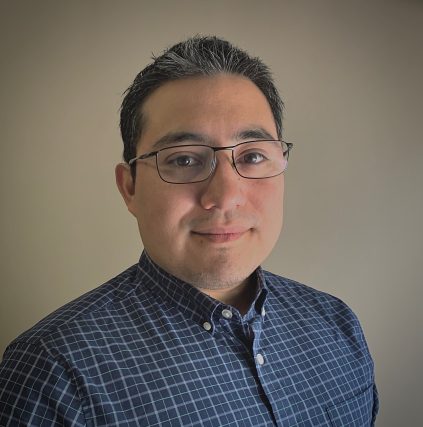Luis QuemeCobar
Education
- Francisco Marroquin University (Guatemala City, Guatemala), 2007, B.S. M.D.
- Nagoya University (Nagoya, Japan), 2013, Ph.D.
Brief Biography
Luis Queme Cobar obtained his BS and MD from the Francisco Marroquin University in Guatemala City, Guatemala in 2007 and received his PhD in Cell Information Medicine from Nagoya University, Nagoya, Japan in 2013.
He then moved to Cincinnati Ohio for a postdoctoral fellowship with Dr. Michael Jankowski at the Division of Pain Management in the Department of Anesthesia at Cincinnati Children’s Hospital where his research focused on the dual role of primary muscle afferents in controlling both nociception and the cardiovascular reflexes in response to muscle activity with the support of a postdoctoral fellowship from the American Heart Association.
In the fall of 2022 he joined the Department of Biomedical Sciences at the University of New England College of Osteopathic Medicine as an Assistant Professor. His research is focused on the interactions between peripheral sensory neurons and other non-neuronal cells and how these may shape the development of chronic pain after exposure to chronic stress.
Current NIH-funded projects focus on the role of macrophages in the development of long-lasting muscle pain using a multidisciplinary approach that combines molecular biology, ex-vivo electrophysiology and AI-driven behavioral analysis.
To reach CV click here.
Publications:
- Queme, L.F., Jankowski, M.P. (2022). Single-Unit Electrophysiological Recordings of Primary Muscle Sensory Neurons Using a Novel Ex Vivo Preparation. In: Seal, R.P. (eds) Contemporary Approaches to the Study of Pain. Neuromethods, vol 178. Humana, New York, NY. https://doi.org/10.1007/978-1-0716-2039-7_6
- Queme LF, J Dourson A, Hofmann MC, Butterfield A, Paladini RD, Jankowski MP. Disruption of Hyaluronic Acid in Skeletal Muscle Induces Decreased Voluntary Activity via Chemosensitive Muscle Afferent Sensitization in Male Mice. eNeuro. 2022 Mar-Apr;9(2). doi: 10.1523/ENEURO.0522-21.2022. Print 2022 Mar-Apr. PubMed PMID: 35387844; PubMed Central PMCID: PMC9014980.
- Nagaraja S, Queme LF, Hofmann MC, Tewari SG, Jankowski MP, Reifman J. In silico Identification of Key Factors Driving the Response of Muscle Sensory Neurons to Noxious Stimuli. Front Neurosci. 2021;15:719735. doi: 10.3389/fnins.2021.719735. eCollection 2021. PubMed PMID: 34566566; PubMed Central PMCID: PMC8461020.
- Queme LF, Weyler AA, Cohen ER, Hudgins RC, Jankowski MP. A dual role for peripheral GDNF signaling in nociception and cardiovascular reflexes in the mouse. Proc Natl Acad Sci U S A. 2020 Jan 7;117(1):698-707. doi: 10.1073/pnas.1910905116. Epub 2019 Dec 17. PubMed PMID: 31848242; PubMed Central PMCID: PMC6955322.
- Queme LF, Jankowski MP. Sex differences and mechanisms of muscle pain. Curr Opin Physiol. 2019 Oct;11:1-6. doi: 10.1016/j.cophys.2019.03.006. Epub 2019 Apr 2. PubMed PMID: 31245656; PubMed Central PMCID: PMC6594402.
- Nasu T, Kubo A, Queme LF, Mizumura K. A single administration of Neurotropin reduced the elongated immobility time in the forced swimming test of rats exposed to repeated cold stress. Behav Pharmacol. 2019 Oct;30(7):547-554. doi: 10.1097/FBP.0000000000000488. PubMed PMID: 31188139.
- He X, Zhang L, Queme LF, Liu X, Lu A, Waclaw RR, Dong X, Zhou W, Kidd G, Yoon SO, Buonanno A, Rubin JB, Xin M, Nave KA, Trapp BD, Jankowski MP, Lu QR. A histone deacetylase 3-dependent pathway delimits peripheral myelin growth and functional regeneration. Nat Med. 2018 Mar;24(3):338-351. doi: 10.1038/nm.4483. Epub 2018 Feb 12. PubMed PMID: 29431744; PubMed Central PMCID: PMC5908710.
- Ross JL, Queme LF, Lamb JE, Green KJ, Ford ZK, Jankowski MP. Interleukin 1β inhibition contributes to the antinociceptive effects of voluntary exercise on ischemia/reperfusion-induced hypersensitivity. Pain. 2018 Feb;159(2):380-392. doi: 10.1097/j.pain.0000000000001094. PubMed PMID: 29112534; PubMed Central PMCID: PMC5927851.
- Ross JL, Queme LF, Lamb JE, Green KJ, Jankowski MP. Sex differences in primary muscle afferent sensitization following ischemia and reperfusion injury. Biol Sex Differ. 2018 Jan 3;9(1):2. doi: 10.1186/s13293-017-0163-5. PubMed PMID: 29298725; PubMed Central PMCID: PMC5751812.
- Queme LF, Ross JL, Jankowski MP. Peripheral Mechanisms of Ischemic Myalgia. Front Cell Neurosci. 2017;11:419. doi: 10.3389/fncel.2017.00419. eCollection 2017. Review. PubMed PMID: 29311839; PubMed Central PMCID: PMC5743676.
- Liu X, Green KJ, Ford ZK, Queme LF, Lu P, Ross JL, Lee FB, Shank AT, Hudgins RC, Jankowski MP. Growth hormone regulates the sensitization of developing peripheral nociceptors during cutaneous inflammation. Pain. 2017 Feb;158(2):333-346. doi: 10.1097/j.pain.0000000000000770. PubMed PMID: 27898492; PubMed Central PMCID: PMC5239735.
- Lu P, Hudgins RC, Liu X, Ford ZK, Hofmann MC, Queme LF, Jankowski MP. Upregulation of P2Y1 in neonatal nociceptors regulates heat and mechanical sensitization during cutaneous inflammation. Mol Pain. 2017 Jan-Dec;13:1744806917730255. doi: 10.1177/1744806917730255. PubMed PMID: 28845731; PubMed Central PMCID: PMC5590703.
- Queme LF, Ross JL, Lu P, Hudgins RC, Jankowski MP. Dual Modulation of Nociception and Cardiovascular Reflexes during Peripheral Ischemia through P2Y1 Receptor-Dependent Sensitization of Muscle Afferents. J Neurosci. 2016 Jan 6;36(1):19-30. doi: 10.1523/JNEUROSCI.2856-15.2016. PubMed PMID: 26740646; PubMed Central PMCID: PMC4701959.
- Queme F, Taguchi T, Mizumura K, Graven-Nielsen T. Muscular heat and mechanical pain sensitivity after lengthening contractions in humans and animals. J Pain. 2013 Nov;14(11):1425-36. doi: 10.1016/j.jpain.2013.07.010. Epub 2013 Sep 21. PubMed PMID: 24064034.
- Murase S, Terazawa E, Queme F, Ota H, Matsuda T, Hirate K, Kozaki Y, Katanosaka K, Taguchi T, Urai H, Mizumura K. Bradykinin and nerve growth factor play pivotal roles in muscular mechanical hyperalgesia after exercise (delayed-onset muscle soreness). J Neurosci. 2010 Mar 10;30(10):3752-61. doi: 10.1523/JNEUROSCI.3803-09.2010. PubMed PMID: 20220009; PubMed Central PMCID: PMC6632252.
- Murase S, Terazawa E, Hirate K, Yamanaka H, Kanda H, Noguchi K, Ota H, Queme F, Taguchi T, Mizumura K. Upregulated glial cell line-derived neurotrophic factor through cyclooxygenase-2 activation in the muscle is required for mechanical hyperalgesia after exercise in rats. J Physiol. 2013 Jun 15;591(12):3035-48. doi: 10.1113/jphysiol.2012.249235. Epub 2013 Apr 15. PubMed PMID: 23587883; PubMed Central PMCID: PMC3832118.

